|
�
�
SULTANS OF SWAP: �Fearing the Gearing!
�
�
 Ever
imagine getting your tie caught in a mechanical set of gears (sorry ladies
- but I will spare you). The results are nasty! Now you know what the
Sultans of Swap in the $695 Trillion global OTC derivatives market feel
like. Every day the slow moving gears of the world
economies relentlessly grind, making it harder and harder for the Sultans
to wiggle loose or breath. Ever
imagine getting your tie caught in a mechanical set of gears (sorry ladies
- but I will spare you). The results are nasty! Now you know what the
Sultans of Swap in the $695 Trillion global OTC derivatives market feel
like. Every day the slow moving gears of the world
economies relentlessly grind, making it harder and harder for the Sultans
to wiggle loose or breath.
�
Financial
Gearing is what we non-accountants often refer to as simply �Leverage�.
�Whichever your preference, it has
the Sultans of Swap tightly caught in a manner that has greatly restricted
their options and is now slowly squeezing the liquidity life out of them.
�
As the
economies of the world adjust to the comatose shock of the Financial
Crisis, the general public is only now awakening to the fall-out and
structural changes resulting from this historic tremor. Some impacts are
obvious; the most important are not - yet!
�
We hear
the word �de-leveraging� almost daily as a tag line whenever the word
�bank� is used. We often hear it when people discuss the amount of debt
the public took on during the housing bubble and are now trying to get out
from under. So we think we know what there is to know about leverage.
Whoa� are we considering all the users and forms of leverage?
�
 The
near collapse of the Shadow Banking mechanism and its exotic gearing
instruments such as SIV, VIE, and SPE working in conjunction with operatives
such as highly leveraged hedge & private equity funds, has left our highly
credit reliant global economies beached. These economies are presently
attempting to swim once again but with pre-crisis business models within a
greatly diminished credit creation infrastructure. We sense something isn�t
working like it did before, but it is much too simplistic to say it is because
credit is more difficult to secure. The
near collapse of the Shadow Banking mechanism and its exotic gearing
instruments such as SIV, VIE, and SPE working in conjunction with operatives
such as highly leveraged hedge & private equity funds, has left our highly
credit reliant global economies beached. These economies are presently
attempting to swim once again but with pre-crisis business models within a
greatly diminished credit creation infrastructure. We sense something isn�t
working like it did before, but it is much too simplistic to say it is because
credit is more difficult to secure.
�
We have
staggering numbers of enterprises that have come into existence or grown to
unsustainable sizes, solely on the basis of the application of leverage. Like
mortgage brokers, appraisers, developers, listing agents, PMI insurers and a
raft of other occupations that exploded during the housing bubble, they have
collapsed just as quickly with de-leveraging. Economists call it
mal-investment. The lay person calls it �unemployment�.
�
We need to
understand more fully the adjustments associated with de-leveraging or
�Reverse Gearing�. As I mentioned, some might call it de-leveraging but that
distracts from the magnitude and scale of what we are presently experiencing.
I like the formal accounting terminology �reverse gearing�; because it makes
it crystal clear the machinery is headed in a different direction.
�
 Financial
Gearing is about any entity increasing debt on its asset liability ledger
relative to its earnings, equity or capital base. By increasing debt it
potentially allows for greater profits or returns to be made. As in Housing,
it is good to have a small down payment and a large mortgage when housing
values are increasing. �Leverage� in this case is positive. However, when
housing prices fall OR interest rates increase, debt leverage levels can be
crippling. A virtuous rising cycle becomes a vicious death spiral. Financial
Gearing is about any entity increasing debt on its asset liability ledger
relative to its earnings, equity or capital base. By increasing debt it
potentially allows for greater profits or returns to be made. As in Housing,
it is good to have a small down payment and a large mortgage when housing
values are increasing. �Leverage� in this case is positive. However, when
housing prices fall OR interest rates increase, debt leverage levels can be
crippling. A virtuous rising cycle becomes a vicious death spiral.
�
When we use
the terms interest and asset prices as we just did, you can be assured that
the next sentence will have something to do with the Wall Street magicians
plying their crafty trade. They are insidious in unlocking the strategies that
live in the world of price, rate and time differentials. None are more shrewd
nor pervasive than the Sultans of Swap.
�
Let�s have a
quick �look see� at how the post financial crisis looks to some key sectors
and where the Sultans of Swap with their
portly derrieres
have
their ties caught.
A)� NON FINANCIAL CORPORATIONS
�
�
The US is no
longer primarily a manufacturing economy nor a service economy. The US has
been operating as a Financial Economy since the Dot Com bubble. To survive and
indeed prosper in this Financial Economy, corporate America was forced to use
its balance sheet both as an engine of growth and as a corporate defense.
Multi-national conglomerates have aggressively practiced this for the last
decade. Exactly the same way the financial & banking industry is structured to
�borrowing short and lend long�, American industry has steadily shortened its
lending duration to shorter and shorter, less costly, short-term financing.
The use of Commercial Paper, easily rolled over on monthly and quarterly
periods, was substantially cheaper than issuing longer term corporate notes
and bonds. Corporations like GM (GMAC), Ford (Ford Credit), GE (GE Capital)
had long ago stopped being industrial corporations. They were financial
corporation�s leveraging their highly competitive credit ratings to borrow
extensively while �leveraging-up� their balance sheets. Corporations were
quick to realize it gave them an unfair competitive advantage in the new
emerging world of financial engineering. The less sophisticated were forced to
follow or be �gobbled up� by competitors with elevated stock valuations.
�
Recent
earnings results have showed us clearly that earnings are now being achieved
by brutal cost cutting efforts to offset revenue shrinkage. Existing �Lines of
Credit� have become more expensive and harder to obtain, especially with
satisfactory terms. �Covenant Lite� loans are now due. Roll-Over of funding
needs are more onerous.
�
Funding
sources, terms and availability have changed adversely and for the foreseeable
future. Corporate America is now strategizing, planning and reacting to this
new reality. Pimco call it the �new normal� of smaller growth rates. It is
called �accelerated unwinding� in corporate board rooms. Increasing corporate
cash hoards are your first signs. (1)

The reason this recession is different is that it is a de-leveraging
recession. We borrowed too much (all over the developed world) and now are
forced to repair our balance sheets as the assets we bought have fallen in
value (housing, bonds, securities, etc.). A new and very interesting (if
somewhat long) study by the McKinsey Global Institute found that periods of
overleveraging are often followed by 6-7 years of slow growth as the
deleveraging process plays out. No quick fixes.
�
Let's look at some of their main conclusions (and they have a solid ten-page
executive summary, worth reading.) This analysis adds new details to the
picture of how leverage grew around the world before the crisis and how the
process of reducing it could unfold.
Here is what McKinsey has to say and is listened to by global board rooms:
�
-
Leverage
levels are still very high in some sectors of several countries - and this
is a global problem, not just a US one.
-
To assess
the sustainability of leverage, one must take a granular view using
multiple sector-specific metrics. The analysis has identified ten sectors
within five economies that have a high likelihood of deleveraging.
-
Empirically,
a long period of deleveraging nearly always follows a major financial
crisis.
-
Deleveraging
episodes are painful, lasting six to seven years on average and reducing
the ratio of debt to GDP by 25 percent.
GDP typically contracts during the first several years and then recovers.
-
If history
is a guide, many years of debt reduction are expected in specific
sectors of some of the world's largest economies, and this process will
exert a significant drag on GDP growth.
-
Coping with
pockets of deleveraging is also a challenge for business executives. The
process portends a prolonged period in which credit is less available and
more costly, altering the viability of some� business models and
changing the attractiveness of different types of investments. In
historic episodes, private investment was often quite low for the duration
of deleveraging. Today, the household sectors of several countries have a
high likelihood of deleveraging. If this happens, consumption growth will
likely be slower than the pre-crisis trend, and spending patterns will
shift. Consumer-facing businesses have already seen a shift in spending
toward value-oriented goods and away from luxury goods, and this new
pattern may persist while households repair their balance sheets. Business
leaders will need flexibility to respond to such shifts.
�
You can read the entire report at their web site, including the ten-page
summary.
http://www.mckinsey.com/mgi/publications/debt_and_deleveraging/index.asp
�
 B)�
PRIVATE EQUITY B)�
PRIVATE EQUITY
�
Presently garnering little media coverage is the historic levels of leveraged
buyouts that have taken place over the last decade using short term money,
pre-financial crisis �covenant lite� terms & extraordinarily geared balance
sheets.
�
Private Equity firms �bought more than 3000 American corporations from 2000 to
2008, employing close to 10 million people � nearly 1 of every 10 workers in
the private sector.
�
The formula was simple: buy a target company with a small down payment and
lots of other people�s money. Leverage it with huge loans using the acquired
company � not the Private Equity firm � as collateral. Cut short-term costs
through radical layoffs. Resell at a profit within 5 years, before the cuts &
debt have totally crippled the business.
�
In ten years Private Equity deals have generated more than $1 Trillion in new
debt � which will come due just when these businesses are least likely to be
able to pay it off. As a result it is forecasted that about half of all
Private Equity owned companies will likely collapse between now and 2015,
throwing 2 million people out of work� (2)
�
�
C)� BANKS & FINANCIAL INSTITUTIONS
�
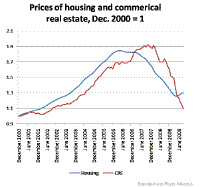 The
raison d��tre of banks is the gearing or leverage of their balance sheets. The
fractional reserve banking system allows the expansion of bank balance sheets
but limits it with reserve requirements. However loans can be increased with
more Capital infusions. The banks have over time, creatively found ways to
utilize debt instruments as capital thereby fulfilling bank regulatory
requirements. These debt instruments, which have been classified as Tier 1
Capital, are custom agreements typically not tradable that can only be valued
by the use of extremely complex proprietary non-auditable bank models. The
assumptions and variables used in these models make their �mark to market�
valuations much closer to �market to myth�. They are blatantly obscure and
totally n The
raison d��tre of banks is the gearing or leverage of their balance sheets. The
fractional reserve banking system allows the expansion of bank balance sheets
but limits it with reserve requirements. However loans can be increased with
more Capital infusions. The banks have over time, creatively found ways to
utilize debt instruments as capital thereby fulfilling bank regulatory
requirements. These debt instruments, which have been classified as Tier 1
Capital, are custom agreements typically not tradable that can only be valued
by the use of extremely complex proprietary non-auditable bank models. The
assumptions and variables used in these models make their �mark to market�
valuations much closer to �market to myth�. They are blatantly obscure and
totally n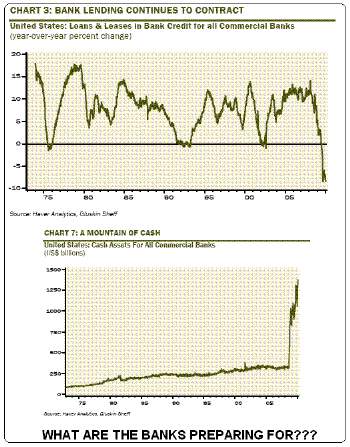 on
transparent to investors. The problem is these �mystical assets� have become
such a large part
of bank capital assets. This has fostered the recent explosion in bank
lending, that current reclassification attempts by bank regulators and the
implementation of the new� International Basel Banking definitions of Tier 1
Assets have led to significant conflicts and crippling potential problems for
the banks.
The solution to date has been to simply defer any changes until the credit
crisis
subsides. Since the investment �community is now aware of the problem but
still cannot get enough information, investment professionals are skeptical of
investing in banks, thereby allowing them to raise capital to allow for future
�adjustments�.�� on
transparent to investors. The problem is these �mystical assets� have become
such a large part
of bank capital assets. This has fostered the recent explosion in bank
lending, that current reclassification attempts by bank regulators and the
implementation of the new� International Basel Banking definitions of Tier 1
Assets have led to significant conflicts and crippling potential problems for
the banks.
The solution to date has been to simply defer any changes until the credit
crisis
subsides. Since the investment �community is now aware of the problem but
still cannot get enough information, investment professionals are skeptical of
investing in banks, thereby allowing them to raise capital to allow for future
�adjustments�.��
����
�If Tier 1 Capital problem is not enough, the banks have also been employing
practices that simply kept alarming amounts of loans off their balance sheets
completely. There are a broad range of practices used but the largest was the
use of SIV�s or Structured Investment Vehicles.� Over the last decade SIV�s
have been a major wheel in using low yielding public money market funds to
foster the procurement of the toxic assets that have become so well covered by
the media. Slowly the banks have had to pull these structures back on their
balance sheets but at a very �measured� and glacially slow rate.
�
�The government is presently keeping the yield curve at a historically steep
rate, for a protracted period of time, to allow the banks time to attempt some
sort of work-out. Unfortunately delinquencies and foreclosures on existing
loans have reached such a level that the net result is barely any real
resolution. Now collapsing Commercial Real Estate values are adding another
truly massive problem to the mix. (3)
�
It is not only the major banks, or the regional banks (which are being taken
over by the FDIC at approaching 3-5 per week � 140 since the crisis began)
that have problems because of excessive gearing. Throughout the financial
services industry the collapsing commercial real estate market is putting
pressures on Insurance companies, Real Estate Developers, REITs, Property
Management Corporations and a whole mix of financial services who are major
holders of commercial real estate assets. Their balance sheet assets are
collapsing, placing their solvency into question and minimally forcing a major
contraction in any new activities.
�
|
� |
2010 |
2011 |
2012 |
2013 |
2014 |
TOTAL |
|
COMMERCIAL REAL ESTATE |
552 |
560 |
537 |
480 |
459 |
2.7T |
|
LEVERAGED BUY-OUT DEBT |
71 |
113 |
203 |
294 |
406 |
� |
|
HIGH YIELD DEBT |
35 |
64 |
75 |
82 |
126 |
� |
|
� |
� |
� |
� |
� |
� |
� |
|
TOTAL |
657 |
737 |
815 |
856 |
992 |
4.2T |
SOURCE: Morgan Stanley, Fixed Income Research & Economics (4)
The above chart from Morgan Stanley, Fixed Income Research & Economics (4)
indicates we will require $4.2 TRILLION in new financing to accommodate loans
of questionable viability, existing lending terms or Loan to collateral value
coming due.
�
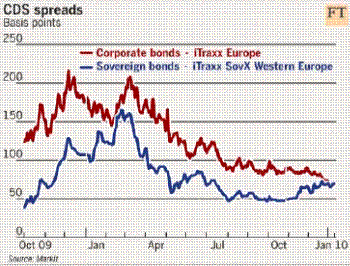 D)�
SOVEREIGN COUNTRIES D)�
SOVEREIGN COUNTRIES
�
I have been
very concerned about all of the items mentioned above, but my biggest concern
is the staggering amounts of debt being increased almost daily � Sovereign
Country Debt. This is not just a USA problem but global, as countries have
taken on debt loads to be used for stimulus fiscal spending. This debt must be
paid!
�
My recent article: �Eight
Financial Fault Lines Appear In The Euro Experiment!�
lays out the undeniable fractures that are occurring. The balance sheet
gearing problem or rather �game� in this instance is how this debt is
presently being funded. In the PIIGS there is large concern with how debt has
been accounted for going back to the inception of the EU and what sovereign
governments did to qualify and gain entry under the Maastricht Treaty.
�
Additionally, Governments are using the �Duration� game to hide the loads.
Specifically they are borrowing on short term duration where interest expenses
are extremely low versus locking in the loan on longer term bonds. The latter
is the traditional manner governments employ to protect taxpayers from
increases in interest rates. New debt and roll-over debt is being funded on
less than 12-18 months terms. This is leaving accelerating balances of debt
which will need re-funding in a year�s time. What happens if interest rates
move up from unprecedented historically low rates to even moderately higher
rates? Why would governments even consider such a strategy?
�
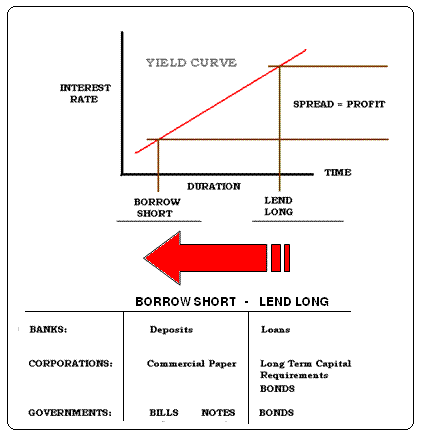
�
Credit Rating agencies are
so concerned about the current situation that they have already started
warning about sovereign credit rating downgrades and in some instances have
downgraded countries such as Greece.
�
Downgrades immediately make new debt issuances for a sovereign country more
expensive. Poor credit ratings and rising rates will quickly bankrupt any
sovereign nation.
�
�
E)� REVERSE GEARING (DELEVERAGING) & ITS GLOBAL RAMIFICATIONS
�
The LEX column in the Financial Times this week observes, concerning the
report:
�
"It may be economically and politically sensible for governments to spend
money on making life more palatable at the height of the crisis. But the
longer countries go on before paying down their debt, the more painful and
drawn-out the process is likely to be. Unless, of course, government bond
investors revolt and expedite the whole shebang."
�
And that is the crux of the matter. We have to raise $1 trillion-plus in the
US from domestic sources. Great Britain has the GDP-equivalent task. So does
much of Europe. Japan is simply off the radar. Japan, as I have noted, is a
bug in search of a windshield.
�
Sometime in the coming few years the bond markets of the world will be
tested. Normally a deleveraging cycle would be deflationary and lower
interest rates would be the outcome. But in the face of such large deficits,
with no home-grown source to meet them? That worked for Japan for 20 years,
as their domestic markets bought their debt. But that process is coming to
an end.
James Carville once famously remarked that when he died he wanted to come
back as the bond market, because that is where the real power is. And I
think we will find out all too soon what the bond vigilantes have to say.
�
And so we have uncertainty all around us. What will our taxes look like in
the US in just 12 months? Health care? Who will finance the bonds, without a
credible plan to reduce the deficit? And any plan that has Nancy Pelosi as
its guarantor is by definition not credible.

The Fed is going to stop the music in March. There will be a scramble for the
chairs. This is a huge experiment with no precedent. The entire developed
world is the test subject. Risk assets will be subject to uncertainty. And
markets hate uncertainty.
�
When the Fed
Stops the Music
Mauldin 01-15-10
�
SULTANS OF
SWAP
�
 I
know many of you are worried about our Sultans of Swap with their ties caught
in the gears. What does this mean to them? More importantly you ask, what does
it mean to us all? I
know many of you are worried about our Sultans of Swap with their ties caught
in the gears. What does this mean to them? More importantly you ask, what does
it mean to us all?
�
Through the magic mix of Credit Default Swaps, Dynamic Hedging and Interest
Rate Swaps the Sultans of Swaps have effectively been controlling interest
rate spreads. Through Regulatory Arbitrage they extorted tremendous political
sway globally. They have existed in the world of risk free spreads. To them
low interest rates simply attract more volume for their concoctions. But this
has changed. Individuals, Corporations, Financial Institutions and Sovereigns
all have more debt than they can handle. Is the global savings growth rate
sufficient to handle further debt growth plus debt associated with possible
compounding interest payments with unpaid balances and roll-overs? We are very
likely nearing a global supply & demand cusp with China�s reserve growth rate
slowing, but without question we are seeing and will see accelerated defaults
from Commercial Real Estate (2) to Sovereign Debt.� We don�t need to see
defaults. How many Greek Sovereign credit downgrades would it take to begin
cascading collateral calls? �
�
�If the US administration�s budgetary projections
are correct, the national debt to GDP ratio will climb from 40% in 2008 to
77.3% in 2020. Even if we are able to curb future deficits, it is likely that
this ratio will grow over the next decade. As a result, rates on treasuries
and other debt obligations are likely to climb over the coming decade with
profound implications for the debt and stock markets.� (5). It is not a matter
of �if� � it is a matter of �when�. With $3.7T in Gross Derivative
Credit Exposure outstanding we are talking some potentially very serious
problems. �
�
 As
I outlined in �Sultans
of Swap � Explaining $605 Trillion in Derivatives�
significant amounts of debt today is hidden in the murky depths of �special�
purpose instruments � like SPE, SPV & SPC or �Structured� entities� like SIV.
This is done to keep debt off the balance sheet. Why would you not want
something on the balance sheet where investors and interested parties could
see what is happening? Obviously so you can camouflage them from what is
happening. The reason is fundamentally Credit Ratings. Keep your debts low,
your credit ratings high and the cost of money is cheap. The cheaper money is,
the more borrowing will occur. Everyone is happy except the unwitting lender. As
I outlined in �Sultans
of Swap � Explaining $605 Trillion in Derivatives�
significant amounts of debt today is hidden in the murky depths of �special�
purpose instruments � like SPE, SPV & SPC or �Structured� entities� like SIV.
This is done to keep debt off the balance sheet. Why would you not want
something on the balance sheet where investors and interested parties could
see what is happening? Obviously so you can camouflage them from what is
happening. The reason is fundamentally Credit Ratings. Keep your debts low,
your credit ratings high and the cost of money is cheap. The cheaper money is,
the more borrowing will occur. Everyone is happy except the unwitting lender.
�
To the right I illustrate the simplest of interest rate swaps. What you need
to appreciate is that everything is normally tied to LIBOR on the floating
leg. LIBOR goes up, one party gets hurt. If rates go up either party could
suffer credit rating downgrades. A credit rating downgrade can and often does
trigger collateral calls. One of the parties then gets hurt. So any
significant moves in interest rates and credit ratings and we have problems.
With $3.7T in Gross Derivative Credit Exposure outstanding we are talking some
potentially serious �hurting�.
�
What we need to differentiate is who exactly the Sultans of Swap are: Are they
the Counterparties A & B who hold the OTC contract? Are they the third party
that administers the ongoing payment exchanges? Are they the issuers or
holders of CDS�s to protect against counterparty failure? Are they the
magicians that put this OTC contract together, took a quick fee and rapidly
left the scene? Are they the banks making almost obscene trading charges
($35B in 2009 trading fees alone (6)) on brokering these swaps from
parties desperate to re-align contract bets since the financial tsunami
arrived? Or is it all of them as cumulative �cohorts in crime�?
�
There is an old saying in poker parlance: �when you look around the table and
you can�t tell who the patsy is � it is you!� I will leave it to you, shrewd
reader, to determine who the patsy is and who the card shark is at this table!
There is only one person holding a risk free winning hand. They may all be
Sultans of Swap but there is only one Emir or Merlin here!
�
What is especially evident to many of these Sultans is that they have their
ties clearly caught. They now foresee a rising LIBOR, likely Credit Rating
downgrades, and probable collateral calls as inevitable in the ongoing process
of reverse gearing. The gears just keep on turning.
�
Let me close with a point of clarification. For those of you having troubles
understanding any of the above, let me relate a story. I was explaining swaps
to a New Yorker who appeared to have no financial background. When I finished
my �swaps in 100 words or less� dissertation he simply nodded his head without
any questions. He then looked me straight in the eye with a knowing expression
and explained. �In New York if I owe the Mob $100 dollars and I can�t pay, but
my best friend Bob owes me $100 and hasn�t paid me yet, then Bob owes the mob
$100. A swap, right? Well, when the mob collects the $100 from Bob, and Bob
now has a broken leg and refuses to ever talk to me again, I still owe the mob
$50 for collection fees plus the �vig� on the original $100. The mob is now up
$150 and I desperately need more friends. A swap, right � yeh I understand!�
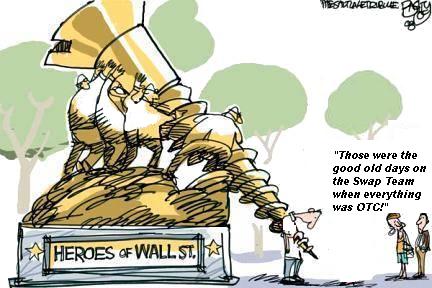
�
SOURCES:
(1) 03-04-10
With Fistfuls of
Cash, Firms on Hunt�
Wall Street Journal
(2)
���������������The Buyout of America� Josh Kosman, Penguin Group, 2009.
Quotation from front jacket flap.
(3) 03-02-10
Realpoint Research Monthly Delinquency Report�
.pdf� Realpoint
(4) 12-16-09
Wall of debt a barrier to US recovery �
The Brisbane Times, Malcolm Maiden
(5) 03-02-10
Obama's Wake Up Call and What It Suggests for Future Interest Rates��
Stephen Shefler
(6) 03-01-10
Frank, Peterson Vow to Eliminate Provision Keeping Swaps Opaque�
Bloomberg
�
McKinsey Global
Institute
http://www.mckinsey.com/mgi/publications/debt_and_deleveraging/index.asp
�
�
TRY our REAL TIME PAGE for the articles you must read
TIPPING POINTS-REAL-TIME
�
Gordon T Long is not a registered advisor and does not give investment advice.
His comments are an expression of opinion only and should not be construed in
any manner whatsoever as recommendations to buy or sell a stock, option, future,
bond, commodity or any other financial instrument at any time. While he believes
his statements to be true, they always depend on the reliability of his own
credible sources. Of course, he recommends that you consult with a qualified
investment advisor, one licensed by appropriate regulatory agencies in your
legal jurisdiction, before making any investment decisions, and barring that, we
encourage you confirm the facts on your own before making important investment
commitments.
�
� Copyright 2010
Gordon T Long. The information herein was obtained from sources which Mr. Long
believes reliable, but he does not guarantee its accuracy. None of the
information, advertisements, website links, or any opinions expressed
constitutes a solicitation of the purchase or sale of any securities or
commodities. Please note that Mr. Long may already have invested or may from
time to time invest in securities that are recommended or otherwise covered on
this website. Mr. Long does not intend to disclose the extent of any current
holdings or future transactions with respect to any particular security. You
should consider this possibility before investing in any security based upon
statements and information contained in any report, post, comment or
recommendation you receive from him.
�
�
�
�
|




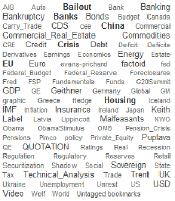






 Financial
Gearing is about any entity increasing debt on its asset liability ledger
relative to its earnings, equity or capital base. By increasing debt it
potentially allows for greater profits or returns to be made. As in Housing,
it is good to have a small down payment and a large mortgage when housing
values are increasing. �Leverage� in this case is positive. However, when
housing prices fall OR interest rates increase, debt leverage levels can be
crippling. A virtuous rising cycle becomes a vicious death spiral.
Financial
Gearing is about any entity increasing debt on its asset liability ledger
relative to its earnings, equity or capital base. By increasing debt it
potentially allows for greater profits or returns to be made. As in Housing,
it is good to have a small down payment and a large mortgage when housing
values are increasing. �Leverage� in this case is positive. However, when
housing prices fall OR interest rates increase, debt leverage levels can be
crippling. A virtuous rising cycle becomes a vicious death spiral. 

